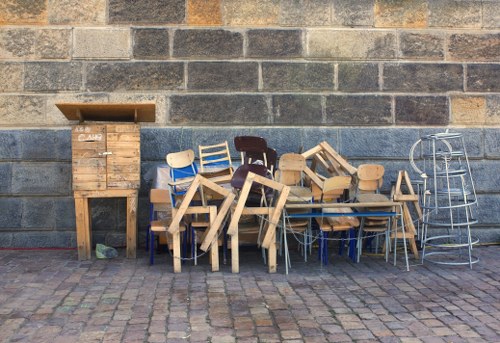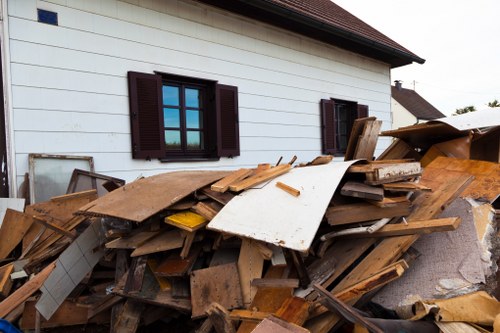Furniture Disposal in Junk Removal Waste: A Comprehensive Guide

Understanding Furniture Disposal
Disposing of old or unwanted furniture is a common challenge faced by many households and businesses. Proper furniture disposal is crucial not only for maintaining a clutter-free environment but also for ensuring environmental sustainability.
When considering junk removal waste, understanding the best practices for getting rid of furniture can save you time, money, and effort. This guide explores various aspects of furniture disposal, including methods, benefits, and essential tips to make the process seamless.
Whether you're upgrading your living space, clearing out an office, or handling estate cleanouts, effective furniture disposal plays a vital role in the overall process.

Why Proper Furniture Disposal Matters
Proper disposal of furniture is essential for several reasons:
- Environmental Impact: Incorrect disposal can lead to increased landfill waste and environmental degradation.
- Legal Compliance: Adhering to local regulations prevents potential fines and legal issues.
- Health and Safety: Proper removal reduces risks associated with old or deteriorating furniture.
- Space Optimization: Efficient disposal frees up valuable space in your home or business.
Understanding these factors underscores the importance of responsible furniture disposal practices.

Methods of Furniture Disposal
1. Donation
Donating furniture is an excellent way to give back to the community while reducing waste. Many charities and non-profit organizations accept gently used furniture.
Benefits of Donating:
- Environmental Sustainability: Reduces landfill contribution.
- Tax Deductions: Donations may be tax-deductible.
- Helping Those in Need: Provides essential items to individuals and families.
How to Donate:
- Assess the condition of your furniture.
- Choose a reputable charity or organization.
- Schedule a pickup or drop-off.
- Ensure proper documentation for tax purposes.

Recycling Furniture
Recycling is another sustainable method for furniture disposal. Many components of furniture, such as metal, wood, and glass, can be recycled.
Steps to Recycle:
- Disassemble the furniture to separate recyclable materials.
- Locate local recycling centers that accept these materials.
- Transport the materials to the recycling facility.
Recycling not only minimizes environmental impact but also conserves natural resources, making it a responsible choice for disposing of old furniture.

Junk Removal Services
For those who prefer a hassle-free solution, junk removal services offer a convenient option. These professionals handle the entire disposal process, ensuring that your furniture is removed efficiently and responsibly.
Advantages of Using Junk Removal Services:
- Time-Saving: Professionals handle all aspects of disposal.
- Proper Disposal: Ensures compliance with local regulations.
- Safety: Reduces the risk of injury from moving heavy items.
- Convenience: Flexible scheduling to accommodate your needs.
When selecting a junk removal service, it's essential to choose a reputable provider that prioritizes sustainability and responsible disposal practices.
Preparing Furniture for Disposal
Proper preparation can streamline the disposal process. Here are some essential steps:
1. Assess the Condition
Determine if the furniture is suitable for donation, recycling, or requires special disposal methods.
2. Clean and Dismantle
Clean the furniture to make it more appealing for donation and dismantle large pieces to facilitate transportation.
3. Remove Hazardous Materials
Ensure that the furniture does not contain hazardous materials like lead paint or asbestos, which require special handling.
Additional Tips:
- Measure doorways and pathways to ensure proper fit during removal.
- Protect floors and walls during the removal process to prevent damage.
Final Checklist:
- Assess and categorize each piece.
- Clean and prepare items as needed.
- Choose the appropriate disposal method.
- Schedule removal or delivery to a donation center.
Environmental Benefits of Responsible Disposal
Choosing responsible furniture disposal methods significantly benefits the environment:
- Reduces Landfill Waste: Less waste means less pollution and extended landfill life.
- Conserves Resources: Recycling materials conserves natural resources like wood and metal.
- Decreases Carbon Footprint: Sustainable practices lower greenhouse gas emissions.
By adopting responsible disposal methods, individuals and businesses contribute to a healthier planet.
Case Studies
Several communities have successfully implemented recycling and donation programs, showcasing the positive impact of responsible furniture disposal.
Cost Considerations
Cost is a significant factor when deciding on a furniture disposal method. Here’s a breakdown of potential costs:
- Donation: Typically free, though some organizations might offer pickup services for a fee.
- Recycling: Costs can vary based on the material and local recycling policies.
- Junk Removal Services: Pricing depends on the volume and type of items being disposed of.
- Landfill Fees: If disposing of furniture yourself, landfill fees may apply.
Assessing these costs helps in making an informed decision that aligns with your budget and disposal needs.
Tips to Save Money:
- Opt for donation to eliminate disposal fees.
- Recycle materials you can to avoid landfill costs.
- Compare quotes from multiple junk removal services for the best rates.
Legal and Regulatory Considerations
Compliance with local laws and regulations is essential when disposing of furniture. Non-compliance can result in fines and other legal consequences.
Understanding Local Regulations:
- Waste disposal laws vary by region; familiarize yourself with local guidelines.
- Some areas have specific rules regarding the disposal of certain materials.
- Proper permits may be required for large-scale disposals.
Penalties for Non-Compliance:
Violating disposal regulations can lead to significant fines and other penalties, emphasizing the need for adherence to local laws.
Staying Informed:
- Consult local government websites for up-to-date information.
- Contact waste management authorities for guidance.
- Use professional services that ensure compliance.
Innovative Disposal Solutions
Advancements in waste management have introduced innovative solutions for furniture disposal.
Upcycling
Upcycling transforms old furniture into new, functional pieces, extending their lifespan and reducing waste.
Repurposing
Repurposing involves modifying furniture to serve a different purpose, such as turning an old dresser into a kitchen island.
Technological Innovations:
- Smart Sorting: Automated systems for efficient material separation.
- Eco-Friendly Materials: Development of sustainable materials for manufacturing and recycling.
Future Trends:
- Increased use of AI in waste management.
- Growth of circular economy models.
- Enhanced recycling technologies.
Choosing the Right Disposal Method
Selecting the appropriate method for furniture disposal depends on various factors:
Condition of Furniture
Assess whether the furniture is in good condition for donation or needs recycling or disposal.
Timeframe
Consider how quickly you need the furniture removed; some methods are faster than others.
Budget
Evaluate the costs associated with each disposal option to find one that fits your financial plan.
Decision-Making Tips:
- Prioritize environmentally friendly options.
- Seek professional advice if unsure.
- Combine methods for optimal results.
Example Scenarios:
- Donating a set of bedroom furniture in good condition.
- Recycling metal frame chairs.
- Using junk removal services for bulky items.
Tips for a Smooth Disposal Process
Ensuring a hassle-free disposal experience involves planning and preparation:
Plan Ahead
Create a timeline and checklist to manage each step of the disposal process effectively.
Hire Professionals
Consider hiring junk removal experts to handle heavy or complex disposals.
Organize Your Space
- Clear pathways for easy removal.
- Label items based on disposal method.
Final Steps:
- Confirm appointments with service providers.
- Ensure all items are ready for pickup.
- Review disposal methods to ensure compliance and sustainability.
Common Challenges and Solutions
Disposing of furniture can present challenges, but with the right approach, they can be overcome:
Space Constraints
Limited space makes it difficult to store furniture before disposal.
Solution:
- Schedule prompt removal appointments.
- Optimize storage areas by decluttering other items.
Cost Management
Balancing disposal costs with budget constraints.
Solution:
- Explore low-cost or free disposal options like donations.
- Compare prices from different junk removal services.
Environmental Concerns
Ensuring that disposal methods are environmentally responsible.
Solution:
- Prioritize recycling and upcycling over landfill disposal.
- Choose services that follow eco-friendly practices.
Conclusion
Effective furniture disposal is integral to maintaining a clean, safe, and environmentally friendly space. By understanding the various disposal methods, their benefits, and how to navigate potential challenges, you can make informed decisions that align with your needs and values.
Whether you opt for donation, recycling, or professional junk removal services, responsible furniture disposal contributes to sustainability and enhances your living or working environment.
Ready to declutter and dispose of your old furniture responsibly? Contact us today to book your service now and take the first step towards a cleaner, greener space.



